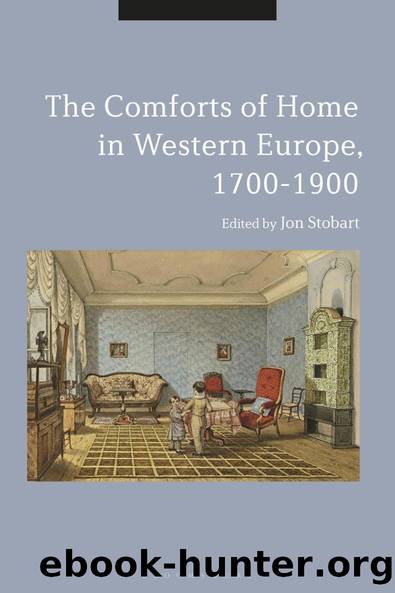The Comforts of Home in Western Europe, 1700-1900 by Jon Stobart

Author:Jon Stobart [Stobart, Jon]
Language: eng
Format: epub
Tags: History
ISBN: 9781350092952
Goodreads: 45892187
Publisher: Bloomsbury Academic
Published: 2020-02-20T00:00:00+00:00
Figure 5.1 Illustration showing the ideal dining room, from H. J. Jennings, Our Homes, and How to Beautify Them (1902).
Figure 5.2 Illustration showing the ideal furnishing for the drawing room, from H. J. Jennings, Our Homes, and How to Beautify Them (1902).
In order to understand how the drawing room was imagined as a location for comfort and for the creation of relationships between men and women, it is useful to turn to advice writing and novels. Advice literature suggests that a certain standard of etiquette and behaviour was expected in the drawing room, that contributed to relations between husbands and wives, and created the right kind of emotional atmosphere. Jennings discusses the atmosphere of the drawing room at length, taking a different tone to Panton but to a similar effect â stressing the emotional and behavioural qualities that went into creating comfort. Again, the room is represented as a polite space in which dress codes and certain rules of etiquette apply. Behaviour is thus conditioned by this atmosphere:
It is thither that you adjourn from the dinner-table to listen to music, or indulge in the lighter intellectual causeries to which all can contribute their share. The inferior sex have cast off, for the time, the habilments of their daily calling, and donned the dress jackets and polished boots of the masculine demi-toilette. The grace and elegancy of the surroundings, no less than the fact that it is the ladies' audience chamber, would exact this confession even if it were not convenient and comfortable in itself. You are in a room which expresses a quality sui generis â a quality of rest, sociability, and comfort in an artistic framework.59
Like Panton, Jennings was expressing a view of the social role of the drawing room, which had already been established in the mid-century novel. In this view, women are primarily responsible for creating the drawing room â femininity imbues it with âgrace and elegancyâ and its special emotional atmosphere of ârest, sociability and comfort.â Victorian novelists often described the drawing room and utilized the shared cultural expectation that it would be a feminine world. The gendering of comfort in the drawing room was imagined in a different way in Anthony Trollopeâs novel Dr Thorne (1858), however. Trollope depicts middle-aged bachelor Dr Thorneâs creation of a drawing room for his niece. Trollopeâs description of the Thorne home as prepared, âas though a Mrs. Thorne with a good fortune was coming home tomorrowâ, underlines the doctorâs devotion to his niece.60 It was customary for Victorian men to prepare their homes to receive their brides, so this statement reinforces Thorneâs commitment. But Trollope also shows the reader Thorneâs efforts to cast the drawing room as a space of emotional comfort. Using a very similar language to that which Panton would later employ to describe the âsmall habitsâ of the drawing room, Trollopeâs description of this polite, intimate space is the foundation of a warm relationship between Thorne and his niece:
He took her first into the shop, and
Download
This site does not store any files on its server. We only index and link to content provided by other sites. Please contact the content providers to delete copyright contents if any and email us, we'll remove relevant links or contents immediately.
Kathy Andrews Collection by Kathy Andrews(11343)
The remains of the day by Kazuo Ishiguro(8418)
Paper Towns by Green John(4811)
Spare by Prince Harry The Duke of Sussex(4806)
Industrial Automation from Scratch: A hands-on guide to using sensors, actuators, PLCs, HMIs, and SCADA to automate industrial processes by Olushola Akande(4632)
The Body: A Guide for Occupants by Bill Bryson(4596)
Machine Learning at Scale with H2O by Gregory Keys | David Whiting(3666)
Be in a Treehouse by Pete Nelson(3654)
Harry Potter and the Goblet Of Fire by J.K. Rowling(3619)
Never by Ken Follett(3550)
Goodbye Paradise(3462)
The Remains of the Day by Kazuo Ishiguro(3148)
Into Thin Air by Jon Krakauer(3135)
The Cellar by Natasha Preston(3079)
The Genius of Japanese Carpentry by Azby Brown(3044)
Fairy Tale by Stephen King(2973)
120 Days of Sodom by Marquis de Sade(2947)
Drawing Shortcuts: Developing Quick Drawing Skills Using Today's Technology by Leggitt Jim(2943)
The Man Who Died Twice by Richard Osman(2824)
